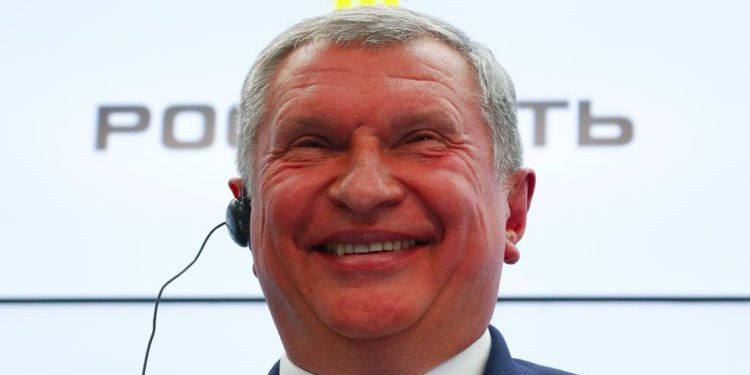Igor Sechin Reported to the President of the Russian Federation on the Implementation of the Largest Rosneft Projects
Vladimir Putin held a working meeting with the Chief Executive Officer of Rosneft PJSC Igor Sechin.
“Rosneft is our leading company, leading company, largest taxpayer,” said Vladimir Putin, opening the meeting.
The President of the Russian Federation invited Igor Sechin, as the head of the largest Russian oil company, to report on the situation in the industry and measures of support from the state. “How do you, as the leader of our largest company, see the situation in the industry as a whole, how Rosneft feels, what problems you consider most important. It is clear to everyone that a drop in demand in the world is the most important problem for everyone. But for us, for Russian power engineers, for Russian oil industry workers, what do you think is the most relevant and what, in your opinion, should the state support be? ”, asked Vladimir Putin.
Igor Sechin noted that in 2019, Rosneft demonstrated significant production and financial and economic results and became the largest taxpayer, including by generating 18 percent of the budget revenue. “The activities of Rosneft support our corporate ecosystem of 2.5 million people – it’s clear that these are contractors, equipment manufacturers, and service companies. The investment program amounted to about 950 billion rubles last year,” the head of Rosneft said.
“Given the dramatic state of the global oil market as a whole and in connection with the decisions taken to reduce production, we will, of course, have to optimize part of the capital costs. We will try to maintain our investment program at about 750 billion,” Sechin said. Optimization is necessary in order to maintain financial and economic stability for the company, he said.
The head of Rosneft emphasized that the company management understands its responsibility for maintaining the health of employees and related families. The company organized 250 isolators in the regions of work, 68 observers, in which the shift before work enters. “We have increased the inter-shift terms from 30 days to 90, people are understanding,” said Sechin. The measures taken give results, the situation is completely under control, he stressed.
Industry support
Speaking about possible measures to support the industry from the state, Igor Sechin called the availability of credit. “The key thing for us, where we urgently need the help of the state, is a softening of the banking policy related to the availability of credit, access to working capital. And this applies not only to us, as you rightly noted, but also to companies, and our contractors, and our suppliers.If there was an opportunity to increase the limits on the lender, it would greatly help to support our investment programs, including even some new ones to start, bearing in mind that in the future two or three years we will nevertheless overcome the crisis, and it will be necessary effectiveness to the market with new volumes of hydrocarbons, “- said Sechin.
He stressed that this is not about soft loans, but about the provision of financing on the terms that are now accepted by the Central Bank.
Also, according to the head of Rosneft, it is necessary to grant a deferment of tax payments for exploration work and bring the tariffs of transport monopolies into line with current prices on the market.
Sechin explained that the transfer of tax payments to future periods for work related to geological exploration will help to carry out the necessary work on projects and in the future be ready to overcome the crisis.
Speaking about the tariffs of natural monopolies, Sechin noted that in 2008 the cost of oil in rubles amounted to about 1,100 rubles, now 1,200 are comparable values. “But earlier the tariff was 822 rubles per tonne, and today it is more than two thousand: 2100 rubles,” the head of Rosneft said.
“We do not ask for any special benefits, but matching in connection with the price drop would, of course, be significant for us. Currently, 32 percent of transport costs are from the cost of oil,” Igor Sechin said in a report to the President of the Russian Federation.
“I understand these concerns, we will definitely discuss this,” Vladimir Putin said in response.
First Russian Aframax
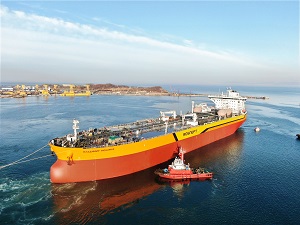 Igor Sechin reported to Vladimir Putin that the Zvezda shipbuilding complex had successfully completed a unique operation to launch the first Russian Aframax tanker, Vladimir Monomakh. A powerful new generation tanker is designed to transport oil in an unlimited navigation area and meets high environmental safety standards, Igor Sechin emphasized.
Igor Sechin reported to Vladimir Putin that the Zvezda shipbuilding complex had successfully completed a unique operation to launch the first Russian Aframax tanker, Vladimir Monomakh. A powerful new generation tanker is designed to transport oil in an unlimited navigation area and meets high environmental safety standards, Igor Sechin emphasized.
“This is a real victory, congratulations,” the President of the Russian Federation said.
The main and auxiliary power plants of the tanker can operate both on traditional and environmentally friendly fuels – liquefied natural gas, which meets the new world environmental standards.
The length of the vessel is 250 meters, width 44 meters, deadweight 114 thousand tons, speed 14.6 knots, ice class ICE-1A. Zvezda’s portfolio already has 12 orders for vessels of this type.
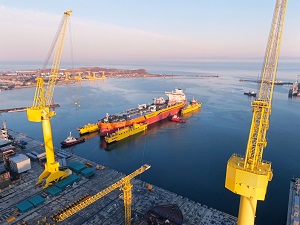 The Aframax tanker was launched using the Vympel transport and transfer dock, one of the largest in Russia. Preparation for the descent took almost a day. During this time, the tanker was rolled by train from an open heavy outfit slipway to a floating dock, and then brought into the water area.
The Aframax tanker was launched using the Vympel transport and transfer dock, one of the largest in Russia. Preparation for the descent took almost a day. During this time, the tanker was rolled by train from an open heavy outfit slipway to a floating dock, and then brought into the water area.
The history of the construction of tankers of this type began with the visit of the President of the Russian Federation Vladimir Putin to the Zvezda SSK in September 2017 – it was then that the package agreement was signed on the design, construction, technical supervision, operation and training of crews of 10 Aframax class tankers.
On September 11, 2018, in the presence of the President of the Russian Federation, the laying of the first Aframax class tanker with a deadweight of 114 thousand tons took place.
Before the launch of the first tanker, four Aframaks were in production on a heavy outfit, and in February 2020 metal was cut for the fifth. Ships are being built for Rosnefteflot. The Aframax tankers will be the first vessels of this type built in Russia. Tankers are equipped with the most advanced Class A automation system.
Project “East Oil”
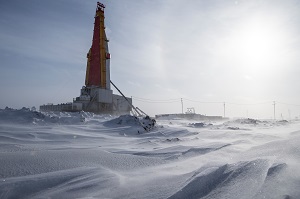 Also, the head of Rosneft reported to the President of the Russian Federation Vladimir Putin about drilling a prospecting and exploration well in the West Irkinskoye license area of one of the largest oil and gas projects in the world, Vostok Oil, which combines the already developed fields of the Vankor group and new fields in the Krasnoyarsk Territory.
Also, the head of Rosneft reported to the President of the Russian Federation Vladimir Putin about drilling a prospecting and exploration well in the West Irkinskoye license area of one of the largest oil and gas projects in the world, Vostok Oil, which combines the already developed fields of the Vankor group and new fields in the Krasnoyarsk Territory.
The resource potential of the Vostok Oil project is more than 5 billion tons of light low-sulfur oil, superior in quality to Brent crude oil. The potential for oil supply to commodity markets is estimated at 20 million tons in 2024, 50 million tons in 2027, and up to 115 million tons by 2030.
Vostok Oil is a powerful generator of economic growth in Russia. The expected economic effect, according to the Institute for Forecasting of the Russian Academy of Sciences, is 9.3 rubles for each ruble invested. The project will provide an additional 2 percent increase in GDP annually.
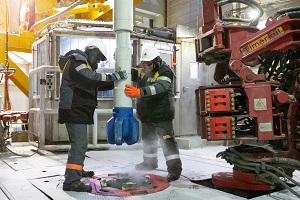 The President set a task for the coming years – to ensure loading of the Northern Sea Route, making it a full-fledged transport artery with year-round navigation.
The President set a task for the coming years – to ensure loading of the Northern Sea Route, making it a full-fledged transport artery with year-round navigation.
Vostok Oil will provide a significant share of freight traffic on the Arctic transport highway. Over 100 million tons of hydrocarbons per year produced at the project’s fields will be transported by ice-class tankers along the Northern Sea Route; these vessels are already being built at the first Zvezda heavy civil shipbuilding shipyard in Russia.
Reference:
The Zvezda shipbuilding complex is being created by a consortium of investors led by Rosneft. During the construction of the shipyard, fundamentally new technological solutions are applied that will allow it to become one of the most modern shipbuilding industries in the world.
The construction of the Zvezda SSK is carried out in two phases, which allowed, without waiting for the completion of work, to proceed with the construction of a number of vessels, including the most complex tankers of the Aframax type. The commissioning of the second stage will expand the capabilities of the shipyard and allow SSK Zvezda to build ships and marine equipment without any restrictions. The shipyard is fully operational – 2024.
The Zvezda product line includes tankers, gas carriers, drilling platforms, ice-class vessels, including the world’s most powerful nuclear icebreakers, Leader. Zvezda will compete with foreign shipyards and provide Russia with a civilian fleet for the development of offshore fields and the smooth operation of the Northern Sea Route – the shortest between Europe and Asia.
The West Irkinskoye license area is located on the Taimyr Peninsula, above the 70th parallel, 400 km north of the Arctic Circle on the right bank of the Yenisei River. The nearest town is Dudinka, located 140 km south of the site.
The Vostok Oil project includes the Vankor cluster (15 deposits, the largest of which are the Suzunskoye, Tagulskoye, Lodochnoe and Vankorskoye deposits), the West Irkinskoye site (Rosneft), the Payakh group of fields (Neftegazholding) and the East Taimyr field a cluster.
Equipment and materials necessary for drilling in the West Irkinskoye section were transported along the Northern Sea Route from the port of Arkhangelsk. About 10 thousand tons of cargo, including equipment and materials, fuel and special equipment, were delivered by the start of drilling.
The design depth of the well will be 4,200 meters with a 1,500 m offset from the vertical. Drilling is carried out by the unique Taimyr-001 drilling rig of the echelon type, with a carrying capacity of 450 tons. The unit is designed for drilling in the Far North, at temperatures up to -50 ° C. Complete shelter of the drilling rig, including the rig, receiving bridge and working areas, allows for wind work of up to 33 m / s, provides high energy efficiency, the most comfortable working conditions and eliminates downtime due to adverse weather conditions.
The drilling rig is equipped with mud collection devices that ensure compliance with the most stringent environmental standards.
The unique geographical position of the project allows transporting oil along the Northern Sea Route to both fast-growing Asian markets and traditional European ones.

